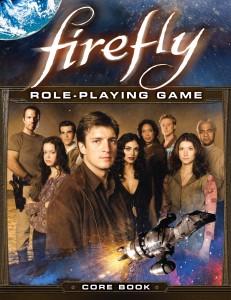Phew! The feedback has started to roll in and, by far, one of the most-talked about aspects of the Firefly RPG corebook is the Episode Guide. At first, the reaction we get is one of dismay. “I already know these shows! I’ve met these characters!” Then, when fans start reading it, words like “brilliant” are tossed around. Ahem. That one made me blush. I don’t know if I’m all that smart…
Anyhoo, the decision to make the Episode Guide a little different than the normal fare was based on a series of key concepts. We also benefited from developing the Episode Guide twice. Two episodes were explored for the GenCon 2013 Exclusive, and that really helped us zero in on the presentation for the corebook. We designed the Episode Guide to:
- Teach new players basic role-playing game concepts. For example, the “Serenity” Pilot shows a mini-scene between Mal and Bendis in Serenity Valley. Each rolls two dice — a very basic dice pool –and the reader is asked to imagine what Bendis might say when Mal tries to cheer him up. Narrating the outcome, after all, is what role-playing is all about. And, in our game? Rolling when failure is interesting is key.
- Introduce the rules so we can reinforce them later. Some gamers really love crunchy books that they can dive into and read for hours on end. Others don’t have that much time, and prefer a book they can read through end-to-end or digest in shorter chunks. The Episode Guide allowed us to introduce the definition of a rule and then show it in action. By reinforcing key concepts in a different way, we hoped we would make all those fiddly bits less intimidating: character creation, ship-building, and, most importantly, what dice to roll and when. It definitely helps that fans already know the Serenity crew and the show!
- Offering multiple examples by applying the rules to scenes. One of the more popular examples I’ve heard about, is the duel we lay out in “Shindig.” Written by Dean Gilbert, we take that duel and go, beat by beat, showing how the rules can be used to facilitate a cinematic scene. We also cover various actions that could happen in a game like single player vs. one antagonist, player vs. player, player vs. ship, ship vs. ship, players vs. antagonists, etc.
- Be faithful to each show. For us, the Episode Guide had two audiences: a Firefly fan interested in rolling dice for the first time and gamers who know the difference between a d100 and percentile die. (Okay, I’m really not funny… But I did try!) Though some fans may not like an Episode Guide, and we did recognize that up front, there are others who expect to see one provided for a game based on fourteen episodes. Once we had a foundation, we then expand on the setting so our ideas are firmly planted in Whedon’s vision. I had a post-it note taped to my monitor when I was writing this game that had these four letters: WWWD. What Would Whedon Do? Did I mention the Chinese? Hee. Remember, we can only cover the show, not the film or the comic books, so our sphere — especially for the corebook — has boundaries. Having said all that, I do want to point out that there are easter eggs. Many. We jammed everything we could into the Episode Guide. We even list the fake Ident cards Wash, Zoe, Mal, and Jayne used in “Ariel”.
- Expand the setting with rules and sample jobs, characters, ships, and locations. As I alluded to above, we also incorporated a setting expansion to put show elements into a gaming context. Someone asked me if the Firefly RPG has enough material to get new ideas for jobs. At last count, there are well over 50 adventure ideas, many of which were provided by Brendan Conway, 75+ GM characters, and dozens of story ideas seeded throughout the book. We also have the benefit of a system that compliments the setting. Cortex Plus, the story-driven rules Firefly RPG employs, is tailored to the show. Asset and Complication examples are names a Browncoat would expect to see, the Distinctions, many of which were designed by P.K. Sullivan, do as well, ships, which were initially created by Dave Chalker and then expanded upon by Dean Gilbert, zero in on the science fiction aspect of this space western, and the sample characters and Episode ideas are all tied to (or inspired by) what happened in each episode.
- Ground the game in story, which is perfect for our rules. Most television shows (Firefly included) don’t have a setting bible right out of the gate. The world is built on-the-fly, per the director’s (e.g. cinematic god’s) needs. (This is also why scripts sometimes change after they’ve been written.) There are no hamsters slaving away, running across thousands of keyboards, adding up mathy bits and ensuring the science is solid. Most of the time, that level of detail is recorded after the fact — when viewers fall in love with a show, as a series continues, or as more content is provided. Firefly, in particular, isn’t “just” a space western. It’s also Whedon’s commentary on the Western genre, and he can get away with that because a) he’s Joss Whedon and b) the ‘Verse is a faraway place and the stories are set 500 years in the future. Our job was to explore what was provided to help fans tell stories of their own.
Phew! Good thing I type fast. I had planned on a shorter post, but hey. It’s Firefly, and it’s totally worth it. Hopefully, this clears up what the Episode Guide is all about. When you see any of my teammates online — past and present — be sure to give ’em a shout! Let me know if you have any questions.
Edit: If you like the Episode Guide, be sure to ALSO thank Amanda Valentine and Philippe-Antoine Menard, who were instrumental in formulating the first iterations of this approach. The layout was designed by Daniel Solis, both times.
Keep flyin’!




Comments are closed.